
Sputnik 1, sometimes referred to as simply Sputnik, was the first artificial Earth satellite. It was launched into an elliptical low Earth orbit by the Soviet Union on 4 October 1957 as part of the Soviet space program. It sent a radio signal back to Earth for three weeks before its three silver-zinc batteries became depleted. Aerodynamic drag caused it to fall back into the atmosphere on 4 January 1958.

A communications satellite is an artificial satellite that relays and amplifies radio telecommunication signals via a transponder; it creates a communication channel between a source transmitter and a receiver at different locations on Earth. Communications satellites are used for television, telephone, radio, internet, and military applications. Many communications satellites are in geostationary orbit 22,236 miles (35,785 km) above the equator, so that the satellite appears stationary at the same point in the sky; therefore the satellite dish antennas of ground stations can be aimed permanently at that spot and do not have to move to track the satellite. Others form satellite constellations in low Earth orbit, where antennas on the ground have to follow the position of the satellites and switch between satellites frequently.
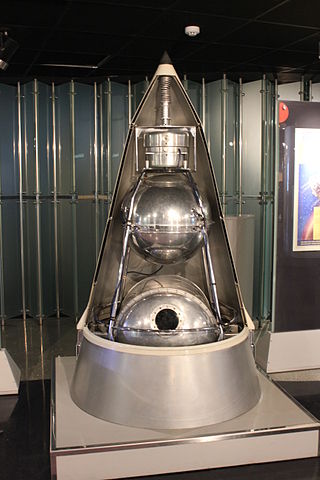
Sputnik 2, or Prosteyshiy Sputnik 2, launched on 3 November 1957, was the second spacecraft launched into Earth orbit, and the first to carry an animal into orbit, a Soviet space dog named Laika.

The Space Race was a 20th-century competition between the Cold War rivals, the United States and the Soviet Union, to achieve superior spaceflight capability. It had its origins in the ballistic missile-based nuclear arms race between the two nations following World War II, and had its peak with the more particular Moon Race to land a man on the Moon between the US moonshot and Soviet moonshot programs. The technological advantage demonstrated by spaceflight achievement was seen as necessary for national security, particularly in regard to intercontinental ballistic missile and satellite reconnaissance capability, but also became part of the cultural symbolism and ideology of the time. The Space Race brought pioneering launches of artificial satellites, robotic landers to the Moon, Venus, and Mars, and human spaceflight in low Earth orbit and ultimately to the Moon.
Project Vanguard was a program managed by the United States Navy Naval Research Laboratory (NRL), which intended to launch the first artificial satellite into low Earth orbit using a Vanguard rocket as the launch vehicle from Cape Canaveral Missile Annex, Florida.

Zond 6 was a formal member of the Soviet Zond program, and an unpiloted version of the Soyuz 7K-L1 crewed Moon-flyby spacecraft. It was launched on a lunar flyby mission on November 10, 1968, from a parent satellite (68-101B) in Earth parking orbit. The spacecraft carried a biological payload of turtles, flies, and bacteria. It also carried scientific probes including cosmic ray, micrometeoroid detectors, and photographic equipment.
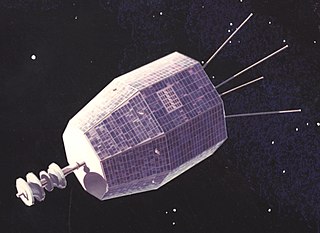
The Relay program consisted of Relay 1 and Relay 2, two early American satellites in elliptical medium Earth orbit. Both were primarily experimental communications satellites funded by NASA and developed by RCA. As of December 2, 2016, both satellites were still in orbit. Relay 1 provided the first American television transmissions across the Pacific Ocean.

The SAMOS or SAMOS-E program was a relatively short-lived series of reconnaissance satellites for the United States in the early 1960s, also used as a cover for the initial development of the KH-7 GAMBIT system. Reconnaissance was performed with film cameras and television surveillance from polar low Earth orbits with film canister returns and transmittals over the United States. SAMOS was first launched in 1960 from Vandenberg Air Force Base.

Courier 1B, is the world's first active repeater communications satellite, Courier 1B was successfully launched on October 4, 1960 at 17:45:00 GMT from Cape Canaveral, Florida. The first Courier satellite in Project Courier, Courier 1A, was lost 2.5 minutes after lift-off on August 18, 1960.

Milstar is a constellation of military communications satellites in geosynchronous orbit, which are operated by the United States Space Force, and provide secure and jam-resistant worldwide communications to meet the requirements of the Armed Forces of the United States. Six spacecraft were launched between 1994 and 2003, of which only five were operational after launch; the third launch failed, both damaging the satellite and leaving it in an unusable orbit.
Lockheed Martin Space is one of the four major business divisions of Lockheed Martin. It has its headquarters in Littleton, Colorado, with additional sites in Valley Forge, Pennsylvania; Sunnyvale, California; Santa Cruz, California; Huntsville, Alabama; and elsewhere in the United States and United Kingdom. The division currently employs about 20,000 people, and its most notable products are commercial and military satellites, space probes, missile defense systems, NASA's Orion spacecraft, and the Space Shuttle external tank.
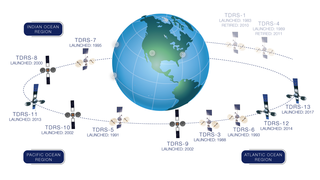
A tracking and data relay satellite (TDRS) is a type of communications satellite that forms part of the Tracking and Data Relay Satellite System (TDRSS) used by NASA and other United States government agencies for communications to and from independent "User Platforms" such as satellites, balloons, aircraft, the International Space Station, and remote bases like the Amundsen-Scott South Pole Station. This system was designed to replace an existing worldwide network of ground stations that had supported all of NASA's crewed flight missions and uncrewed satellites in low-Earth orbits. The primary system design goal was to increase the amount of time that these spacecraft were in communication with the ground and improve the amount of data that could be transferred. These TDRSS satellites are all designed and built to be launched to and function in geosynchronous orbit, 35,786 km (22,236 mi) above the surface of the Earth.
Canyon was a series of seven United States spy satellites launched between 1968 and 1977. Also known by its program number AFP-827, the satellites were developed with the participation of the Air Force. The Canyon project is credited as being the first American satellite system tasked for COMINT.

Atlas is a family of US missiles and space launch vehicles that originated with the SM-65 Atlas. The Atlas intercontinental ballistic missile (ICBM) program was initiated in the late 1950s under the Convair Division of General Dynamics. Atlas was a liquid propellant rocket burning RP-1 kerosene fuel with liquid oxygen in three engines configured in an unusual "stage-and-a-half" or "parallel staging" design: two outboard booster engines were jettisoned along with supporting structures during ascent, while the center sustainer engine, propellant tanks and other structural elements remained connected through propellant depletion and engine shutdown.

Space Systems Command (SSC) is the United States Space Force's space development, acquisition, launch, and logistics field command. It is headquartered at Los Angeles Air Force Base, California, and manages the United States' space launch ranges.

The Missile Defense Alarm System, or MIDAS, was a United States Air Force Air Defense Command system of 12 early-warning satellites that provided limited notice of Soviet intercontinental ballistic missile launches between 1960 and 1966. Originally intended to serve as a complete early-warning system working in conjunction with the Ballistic Missile Early Warning System, cost and reliability concerns limited the project to a research and development role. Three of the system's 12 launches ended in failure, and the remaining nine satellites provided crude infrared early-warning coverage of the Soviet Union until the project was replaced by the Defense Support Program. MiDAS represented one element of the United States's first generation of reconnaissance satellites that also included the Corona and SAMOS series. Though MIDAS failed in its primary role as a system of infrared early-warning satellites, it pioneered the technologies needed in successor systems.
Kosmos 53, also known as DS-A1 No.5 was a technology demonstration satellite which was launched by the Soviet Union in 1965 as part of the Dnepropetrovsk Sputnik programme. Its primary mission was to demonstrate technologies for future Soviet military satellites. It also conducted radiation experiments.
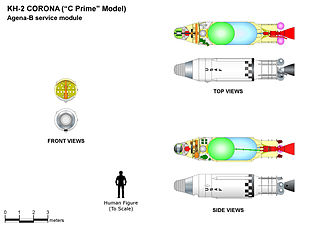
Discoverer 18, also known as Corona 9013, was an American optical reconnaissance satellite launched on 7 December 1960 at 20:24:00 GMT. It was the first successful, and the third of ten total Corona KH-2 satellites, based on the Agena-B.

The National Aeronautics and Space Administration (NASA) was created in 1958 from the National Advisory Committee for Aeronautics (NACA), and other related organizations, as the result of the Space Race between the United States and the Soviet Union in the 1950s.
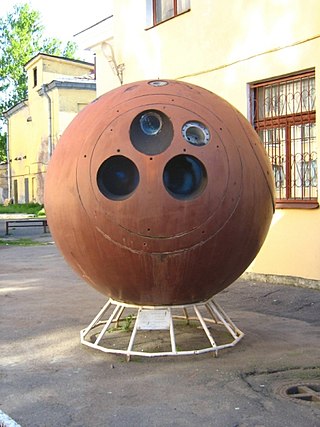
Kosmos 13 or Zenit-2 No.8 was a Soviet optical film-return reconnaissance satellite launched in 1963. A Zenit-2 spacecraft, Kosmos 13 was the eighth of eighty-one such satellites to be launched.

















